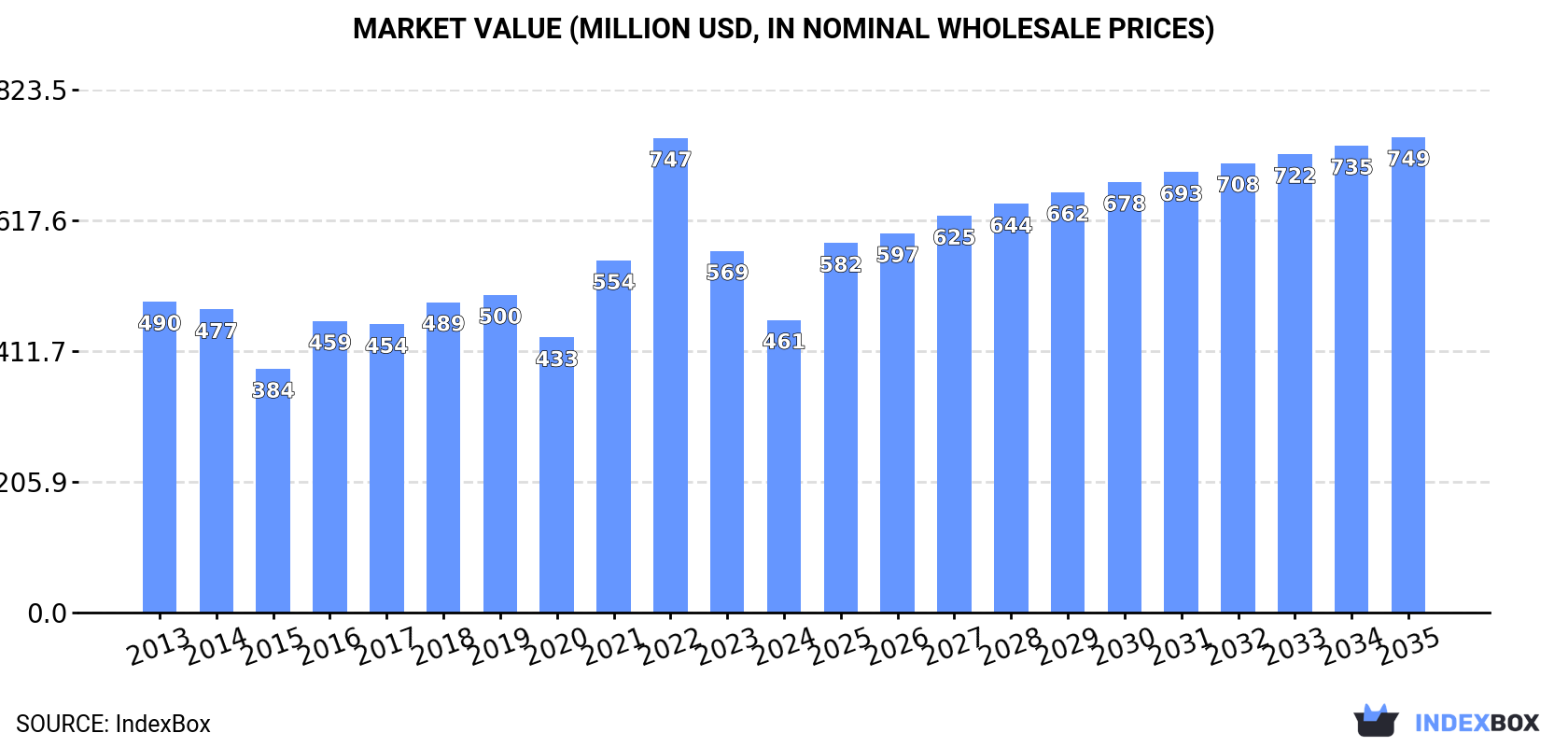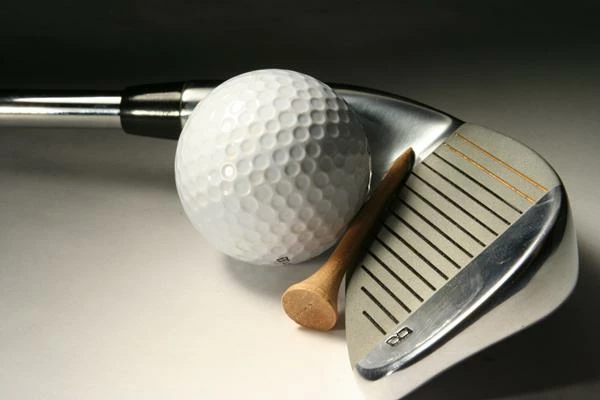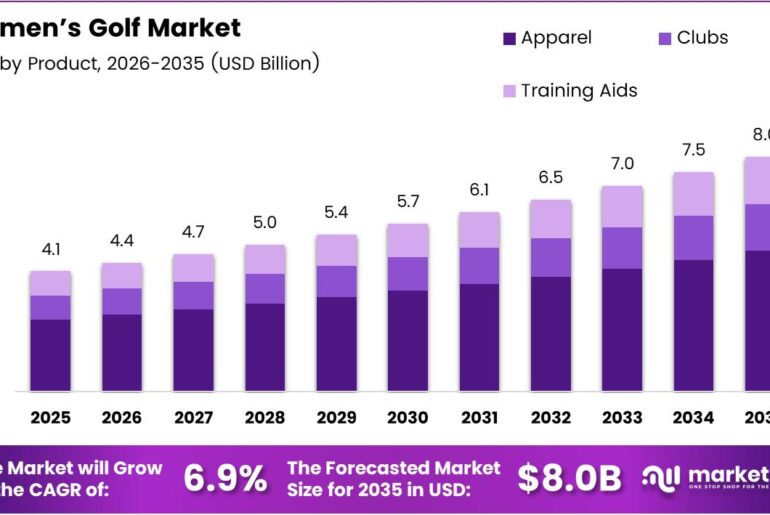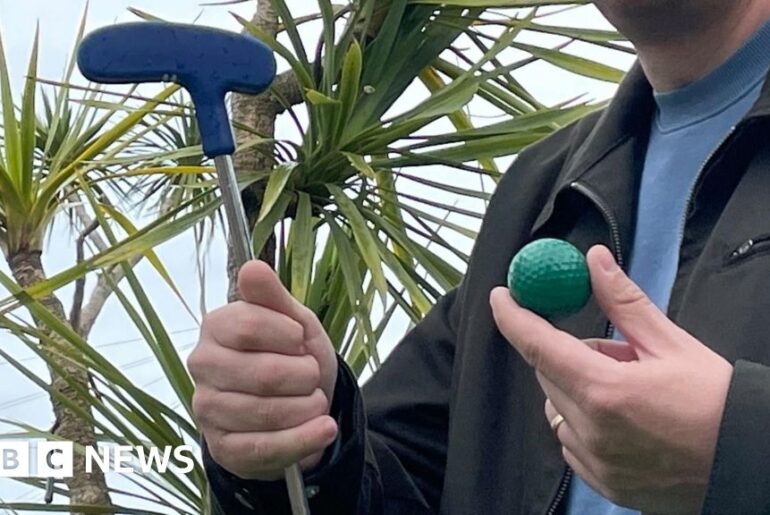May 24, 2025
IndexBox has just published a new report: Japan – Golf Clubs And Other Golf Equipment – Market Analysis, Forecast, Size, Trends and Insights.
Driven by increasing demand for golf equipment in Japan, the market is expected to show positive growth trends in the coming years. Forecasts predict a slight increase in market performance, with a projected volume of 396M units and a market value of $749M by 2035.
Market Forecast
Driven by rising demand for golf equipment in Japan, the market is expected to start an upward consumption trend over the next decade. The performance of the market is forecast to increase slightly, with an anticipated CAGR of +1.6% for the period from 2024 to 2035, which is projected to bring the market volume to 396M units by the end of 2035.
In value terms, the market is forecast to increase with an anticipated CAGR of +4.5% for the period from 2024 to 2035, which is projected to bring the market value to $749M (in nominal wholesale prices) by the end of 2035.
 ConsumptionJapan’s Consumption of Golf Clubs And Other Golf Equipment
ConsumptionJapan’s Consumption of Golf Clubs And Other Golf Equipment
In 2024, consumption of golf clubs and other golf equipment decreased by -14.3% to 334M units, falling for the second year in a row after two years of growth. Overall, consumption recorded a pronounced setback. Over the period under review, consumption attained the peak volume at 477M units in 2022; however, from 2023 to 2024, consumption failed to regain momentum.
The revenue of the golf equipment market in Japan reduced rapidly to $461M in 2024, declining by -19.1% against the previous year. This figure reflects the total revenues of producers and importers (excluding logistics costs, retail marketing costs, and retailers’ margins, which will be included in the final consumer price). In general, consumption recorded a relatively flat trend pattern. As a result, consumption attained the peak level of $747M. From 2023 to 2024, the growth of the market remained at a somewhat lower figure.
ProductionJapan’s Production of Golf Clubs And Other Golf Equipment
Golf equipment production in Japan fell to 94M units in 2024, which is down by -2.6% against the previous year’s figure. In general, production continues to indicate a abrupt slump. The most prominent rate of growth was recorded in 2019 when the production volume increased by 13% against the previous year. Golf equipment production peaked at 188M units in 2013; however, from 2014 to 2024, production stood at a somewhat lower figure.
In value terms, golf equipment production dropped notably to $284M in 2024 estimated in export price. Over the period under review, production showed a abrupt curtailment. The most prominent rate of growth was recorded in 2015 when the production volume decreased by -0.7%. Over the period under review, production reached the peak level at $676M in 2013; however, from 2014 to 2024, production failed to regain momentum.
ImportsJapan’s Imports of Golf Clubs And Other Golf Equipment
In 2024, purchases abroad of golf clubs and other golf equipment decreased by -14.5% to 349M units, falling for the second consecutive year after two years of growth. Over the period under review, imports, however, continue to indicate a relatively flat trend pattern. The pace of growth was the most pronounced in 2021 when imports increased by 29%. Over the period under review, imports reached the maximum at 506M units in 2022; however, from 2023 to 2024, imports stood at a somewhat lower figure.
In value terms, golf equipment imports declined to $670M in 2024. Overall, imports recorded a mild setback. The growth pace was the most rapid in 2021 with an increase of 38% against the previous year. Over the period under review, imports reached the maximum at $1.1B in 2022; however, from 2023 to 2024, imports failed to regain momentum.
Imports By Country
In 2024, China (167M units) constituted the largest golf equipment supplier to Japan, accounting for a 48% share of total imports. Moreover, golf equipment imports from China exceeded the figures recorded by the second-largest supplier, Thailand (46M units), fourfold. Taiwan (Chinese) (45M units) ranked third in terms of total imports with a 13% share.
From 2013 to 2024, the average annual rate of growth in terms of volume from China totaled -1.5%. The remaining supplying countries recorded the following average annual rates of imports growth: Thailand (-0.4% per year) and Taiwan (Chinese) (-0.8% per year).
In value terms, China ($325M) constituted the largest supplier of golf clubs and other golf equipment to Japan, comprising 48% of total imports. The second position in the ranking was held by Vietnam ($106M), with a 16% share of total imports. It was followed by Taiwan (Chinese), with a 14% share.
From 2013 to 2024, the average annual growth rate of value from China stood at -4.5%. The remaining supplying countries recorded the following average annual rates of imports growth: Vietnam (+23.9% per year) and Taiwan (Chinese) (+4.1% per year).
Imports By Type
In 2024, golf equipment; other than clubs and balls (261M units) constituted the largest type of golf clubs and other golf equipment supplied to Japan, with a 75% share of total imports. Moreover, golf equipment; other than clubs and balls exceeded the figures recorded for the second-largest type, golf balls (85M units), threefold.
From 2013 to 2024, the average annual rate of growth in terms of the volume of golf equipment; other than clubs and balls imports was relatively modest. With regard to the other supplied products, the following average annual rates of growth were recorded: golf balls (-1.4% per year) and golf clubs; complete (-4.6% per year).
In value terms, golf clubs and other golf equipment with the largest imports in Japan were golf equipment; other than clubs and balls ($367M), golf clubs; complete ($209M) and golf balls ($95M).
Among the main product categories, golf equipment; other than clubs and balls, with a CAGR of +1.7%, recorded the highest rates of growth with regard to the value of imports, over the period under review, while purchases for the other products experienced mixed trend patterns.
Import Prices By Type
In 2024, the average golf equipment import price amounted to $1.9 per unit, picking up by 6.1% against the previous year. Overall, the import price, however, showed a mild curtailment. The most prominent rate of growth was recorded in 2017 when the average import price increased by 14% against the previous year. Over the period under review, average import prices hit record highs at $2.2 per unit in 2013; however, from 2014 to 2024, import prices stood at a somewhat lower figure.
Prices varied noticeably by the product type; the product with the highest price was golf clubs; complete ($72 per unit), while the price for golf balls ($1.1 per unit) was amongst the lowest.
From 2013 to 2024, the most notable rate of growth in terms of prices was attained by golf balls (+2.6%), while the prices for the other products experienced mixed trend patterns.
Import Prices By Country
In 2024, the average golf equipment import price amounted to $1.9 per unit, growing by 6.1% against the previous year. Overall, the import price, however, saw a mild curtailment. The most prominent rate of growth was recorded in 2017 an increase of 14% against the previous year. The import price peaked at $2.2 per unit in 2013; however, from 2014 to 2024, import prices stood at a somewhat lower figure.
Prices varied noticeably by country of origin: amid the top importers, the country with the highest price was Vietnam ($2.7 per unit), while the price for South Korea ($1 per unit) was amongst the lowest.
From 2013 to 2024, the most notable rate of growth in terms of prices was attained by South Korea (+5.9%), while the prices for the other major suppliers experienced more modest paces of growth.
ExportsJapan’s Exports of Golf Clubs And Other Golf Equipment
In 2024, shipments abroad of golf clubs and other golf equipment decreased by -5.2% to 109M units, falling for the second consecutive year after two years of growth. In general, total exports indicated a modest expansion from 2013 to 2024: its volume increased at an average annual rate of +1.3% over the last eleven years. The trend pattern, however, indicated some noticeable fluctuations being recorded throughout the analyzed period. Based on 2024 figures, exports decreased by -9.2% against 2022 indices. The growth pace was the most rapid in 2021 when exports increased by 34%. The exports peaked at 120M units in 2022; however, from 2023 to 2024, the exports failed to regain momentum.
In value terms, golf equipment exports fell remarkably to $331M in 2024. Overall, exports continue to indicate a relatively flat trend pattern. The pace of growth appeared the most rapid in 2021 when exports increased by 29% against the previous year. The exports peaked at $539M in 2022; however, from 2023 to 2024, the exports failed to regain momentum.
Exports By Country
The United States (27M units), China (25M units) and South Korea (22M units) were the main destinations of golf equipment exports from Japan, with a combined 68% share of total exports. The UK, Australia, Thailand, the Netherlands, Vietnam and Hong Kong SAR lagged somewhat behind, together comprising a further 25%.
From 2013 to 2024, the most notable rate of growth in terms of shipments, amongst the main countries of destination, was attained by the Netherlands (with a CAGR of +356.2%), while the other leaders experienced more modest paces of growth.
In value terms, South Korea ($180M) remains the key foreign market for golf clubs and other golf equipment exports from Japan, comprising 54% of total exports. The second position in the ranking was taken by the United States ($34M), with a 10% share of total exports. It was followed by China, with an 8.2% share.
From 2013 to 2024, the average annual rate of growth in terms of value to South Korea was relatively modest. Exports to the other major destinations recorded the following average annual rates of exports growth: the United States (+2.7% per year) and China (+0.2% per year).
Exports By Type
Golf equipment; other than clubs and balls (56M units), golf balls (50M units) and golf clubs; complete (3M units) were the main products of golf equipment exports from Japan.
From 2013 to 2024, the most notable rate of growth in terms of shipments, amongst the major product types, was attained by golf equipment; other than clubs and balls (with a CAGR of +1.3%), while the other products experienced more modest paces of growth.
In value terms, golf clubs; complete ($240M) remains the largest type of golf clubs and other golf equipment exported from Japan, comprising 72% of total exports. The second position in the ranking was taken by golf equipment; other than clubs and balls ($66M), with a 20% share of total exports.
From 2013 to 2024, the average annual growth rate of the value of golf clubs; complete exports was relatively modest. With regard to the other exported products, the following average annual rates of growth were recorded: golf equipment; other than clubs and balls (+0.1% per year) and golf balls (+1.9% per year).
Export Prices By Type
The average golf equipment export price stood at $3 per unit in 2024, falling by -20.4% against the previous year. Over the period under review, the export price continues to indicate a slight downturn. The growth pace was the most rapid in 2014 when the average export price increased by 18%. Over the period under review, the average export prices reached the maximum at $4.9 per unit in 2015; however, from 2016 to 2024, the export prices remained at a lower figure.
Prices varied noticeably by the product type; the product with the highest price was golf clubs; complete ($80 per unit), while the average price for exports of golf balls ($502 per thousand units) was amongst the lowest.
From 2013 to 2024, the most notable rate of growth in terms of prices was recorded for the following types: golf balls (+0.7%), while the prices for the other products experienced a decline.
Export Prices By Country
In 2024, the average golf equipment export price amounted to $3 per unit, reducing by -20.4% against the previous year. In general, the export price continues to indicate a mild shrinkage. The growth pace was the most rapid in 2014 when the average export price increased by 18% against the previous year. The export price peaked at $4.9 per unit in 2015; however, from 2016 to 2024, the export prices failed to regain momentum.
There were significant differences in the average prices for the major external markets. In 2024, amid the top suppliers, the country with the highest price was South Korea ($8.3 per unit), while the average price for exports to the UK ($749 per thousand units) was amongst the lowest.
From 2013 to 2024, the most notable rate of growth in terms of prices was recorded for supplies to the UK (+4.2%), while the prices for the other major destinations experienced more modest paces of growth.
Source: IndexBox Market Intelligence Platform







